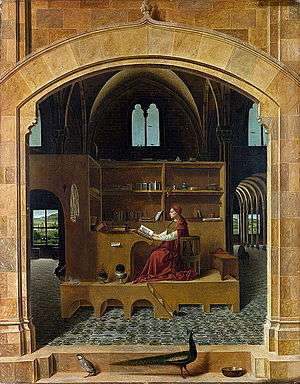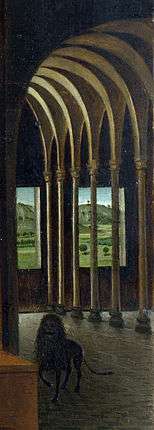St. Jerome in His Study (Antonello da Messina)
St. Jerome in His Study is a painting by the Italian Renaissance master Antonello da Messina, thought to have been completed c. 1475. It is in the collection of the National Gallery, London.
| St. Jerome in His Study | |
|---|---|
 | |
| Artist | Antonello da Messina |
| Year | c. 1474–1475 |
| Type | Oil on wood |
| Dimensions | 45.7 cm × 36.2 cm (18.0 in × 14.3 in) |
| Location | National Gallery, London |
The picture was painted by Antonello during his Venetian sojourn, and was the property of Antonio Pasqualino.
Description

The small picture portrays St. Jerome working in his studio, a room without walls and ceiling seen from a kind of triumphal arch (probably within some church of Aragonese style). As in several other works by the Messinese painter, the main scene is accompanied by a host of details, that have points of contact with the contemporary Flemish school: books, animals, objects, all painted with a magnificent taste for detail and "optical truth".
The scene is devised such that the light rays coincide with the perspective axes, centring on the saint's bust and hands. A Mediterranean landscape is hinted at through the windows opening on both sides of the study. Animals include a partridge (Alectoris graeca) and a peacock, in the foreground, both having symbolical meanings, a cat and a lion, typically associated with St Jerome, in the shade on the right.
Symbolism
Antonello uses many symbols throughout the painting. The book St. Jerome is reading represents knowledge. The books surrounding him refer to his translation of the Bible into Latin, the Vulgate. The lion in the shadows to the right of the saint is from a story about St. Jerome pulling a thorn out of a lion's paws. In gratitude, the lion follows St. Jerome around for the rest of his life, like a house cat. The peacock and partridge play no specific part in the story of St. Jerome. However, the peacock generally symbolizes immortality, and the partridge is an ambivalent reference to truth/deceit.
References
- Battisti, Eugenio. Antonello, il teatro sacro, gli spazi, la donna (Il labirinto). Palermo: Novecento. ISBN 88-373-0021-2.
Further reading
- Barbera, K, ed. (2005). Antonello da Messina : Sicily's Renaissance master. New York: The Metropolitan Museum of Art.